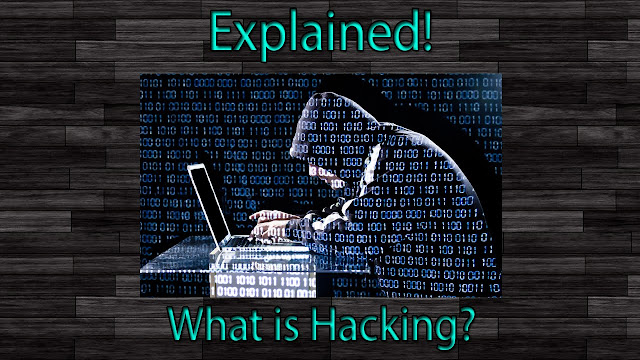Hacker Information
 |
| Hacker Information |
Hacker
What Is Hacking?
Hacking is an attempt to exploit a computer system or a private network inside a computer. Simply put, it is the unauthorised access to or control over computing network security systems for some illicit purpose. ... White hat professionals hack to check their own security systems to make it more hack-proof
Or
What are The 3 Types of hackers?
Hacking is usually divided into three categories: White Hat Hacker Black Hat Hacker Gray Hat Hacker.
The three types of hackers are the white hat hacker, the grey hat hacker, and the black hat hacker. Each type of hacker hacks for a different reason, a cause, or both. All have the required skills needed to accomplish their mission.
White-Hat hacker is a computer security specialist who breaks into protected systems and networks to test and asses their security. White hat hackers use their skills to improve security by exposing vulnerabilities before malicious hackers [known as black hat hackers] can detect and exploit them.
Black Hat Hacker refers to a hacker who breaks into a computer system or network with malicious intent. A black hat hacker may exploit security vulnerabilities for monetary gain; to steal or destroy private data; or to alter, disrupt or shut down websites and networks.
Grey Hat Hacker is a computer hacker or computer security expert who may sometimes violate laws or typical ethical standards but does not have the malicious intent typical of a black hat hacker.
Which type of hacker is best?
1. Script Kiddie Script Kiddies normally don't care about hacking if they did, they'd be Green Hats. See below. They copy code and use it for a virus or an SQLi or something else. Script Kiddies will never hack for themselves; they'll just download overused software (LOIC or Metasploit, for example) and watch a YouTube video on how to use it. A common Script Kiddie attack is DoSing or DDoSing (Denial of Service and Distributed Denial of Service), in which they flood an IP with so much information it collapses under the strain. This attack is frequently used by the "hacker" group Anonymous, which doesn't help anyone's reputation.
2. White Hat Also known as ethical hackers, White Hat hackers are the good guys of the hacker world. They'll help you remove a virus or PenTest a company. Most White Hat hackers hold a college degree in IT security or computer science and must be certified to pursue a career in hacking. The most popular certification is the CEH (Certified Ethical Hacker) from the EC-Council.
3. Black Hat Also known as crackers, these are the men and women you hear about in the news. They find banks or other companies with weak security And steal money or credit card information. The surprising truth about their methods of attack is that they often use common hacking practices they learned early on.
4. Gray Hat Nothing is ever just black or white; the same is true in the world of hacking. Gray Hat hackers don't steal money or information (although, sometimes they deface a website or two), yet they don't help people for good (but, they could if they wanted to). These hackers comprise most of the hacking world, even though Black Hat hackers garner most (if not all) of the media's attention.
 |
| Ethical Hackers |
5.Green Hat These are the hacker "n00bz," but unlike Script Kiddies, they care about hacking and strive to become full-blown hackers. They're often flamed by the hacker community for asking many basic questions. When their questions are answered, they'll listen with the intent and curiosity of a child listening to family stories.
6. Red Hat These are the vigilantes of the hacker world. They're like White Hats in that they halt Black Hats, but these folks are downright SCARY to those who have ever tried so much as PenTest. Instead of reporting the malicious hacker, they shut him/her down by uploading viruses, DoSing and accessing his/her computer to destroy it from the inside out. They leverage multiple aggressive methods that might force a cracker to need a new computer.
7. Blue Hat If a Script Kiddie took revenge, he/she might become a Blue Hat. Blue Hat hackers will seek vengeance on those who've them angry. Most Blue Hats are n00bz, but like the Script Kiddies, they have no desire to learn.
 |
| Hacker Information |
What language do hackers use?
Languages such as C and C++ are considered as programming languages whereas languages such as ruby, Perl and python are considered more as scripting languages.
What is Web hacking?
Hacking a website is the process of exploiting vulnerabilities of the target website in order to gain unauthorized privileges to it. It consists of many phases like information gathering, vulnerability analysis, etc. and the attacks include Defacing, SQL injection, DDoS, PDoS, etc.
What methods do hackers use?
Phishing
One of the most insidious techniques used today is Phishing. It’s hard to find the person that doesn’t know what phishing is. However, a lot of users are still getting tricked by hackers on a daily basis. Phishing implies the replication of the website with the aim of stealing money or personal information. And once a user enters his credit card details, for example, a hacker will have access to that data and will be able to use the received information for his own benefit.
Viruses and malicious code
Hackers can crawl almost into any website and leave in its’ database malware or insert code into the website’s files. There is a huge variety of viruses, and each may impact the infected site differently. But there should be no doubt that a virus, regardless of its type, will not benefit your business.
UI Redress
This technique is similar to phishing. But in this case, a hacker would create a fake hidden user interface. Once the a user clicks the button with an intention of to proceed to a certain page, he will find himself on an unfamiliar website, usually with inappropriate content.
Cookie Theft
With the help of malicious software, hackers can steal your browser’s cookies. And those cookies contain a lot of important information: browsing history, usernames and passwords. As you understand, that data can also contain logins and password to your website’s administrator’s panel.
Denial of Service (DoS\DDoS)
DDOS stands for Distributed Denial of Service. A DDOS attack is a way to make a certain server unavailable or, in other words, a way to crash the server.
To interrupt or crash the server a hacker would use bots. Those bots sole purpose is to send requests to the website, a lot of requests. As a result, a server unable to process all of the received requests will simply crash. The most hazardous thing about this technique is that a hacker can crash the server in a relatively small amount of time
DNS spoofing
This malware is also known as DNS cache poisoning. It engages that old cache data you might have forgotten about.
Vulnerabilities in the domain name system allow hackers to redirect traffic from your website to a malicious one. Moreover, hackers can program this attack so the infected DNS server will infect another DNS and so on.
SQL injection
If your website has vulnerabilities in its SQL database or libraries, hackers can get access to your confidential information by deceiving the system. So there is no surprise that SQL injections can also be a simple tool. But this simple tool can allow a hacker to access vital information about your website.
Keylogger injection
The Keylogger that very simple and dangerous malicious code.
The malware records keystrokes capture all of the user’s actions on the keyboard, and to send all that has been recorded to the hackers; it also installs a malicious script that produces an in-browser cryptocurrency miner. If a hacker succeeds in obtaining data, then the result of the hacking will be stolen admin credentials that can allow hackers to easily log into your website
Non-targeted website hack
In most cases, hackers don’t target a specific website. They are more interested in massive hacking. It is easy to suffer from a non-targeted attack – you just need to overlook any CMS, plugin or template vulnerability. Any gap is a chance to get into the hacker’s sight and become a victim during the next attack.
Hackers can find websites with similar weaknesses easily. They can always use Google’s Hacking Database to receive a list of vulnerable websites that have the same properties. For example, hackers can find all indexed websites that have a vulnerable plugin installed. Or websites with unhidden catalogues.
Brute force
A Brute Force Attack is the simple method to gain access to a website. It tries various combinations of the passwords again and again until it gets in. This repetitive action is like an army attacking a fort.
1 2 3 4 5 6 7 8 9 10 [Previus Page] [Nest Page]





Comments
Post a Comment